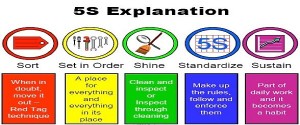
Imagine you wake up one morning realising you have a sore head, the usual remedies don’t work, you think it may even be something quite serious, you take a trip to the Doctor’s, then imagine your surprise when the Doctor asks you no questions but suggests the real problem is your leg, even worse the remedy is simply more aspirin, wouldn’t you be concerned? I’m sure this situation never occurs in a Doctor’s surgery but in local councils all over Scotland improper diagnosis and prescription error are soon to be the way of dealing with organisational ills. And the new medicine: Kaizen Blitz.
Kaizen Blitz seems like a rational way to go about change.
Get the managers to define a problem, label all the parts of the process that seem wasteful, brainstorm ideas for the removal of said waste, and instantly implement the change to those who work in the operations (including many individuals that were not privy to the project and its goals). Supporters of the method claim that it gives people an idea how much change can be created in a short period of time (a day or so), thus creating an appetite for continuous improvement through the whole organisation. And don’t get me wrong I am not a naysayer to improving our public services – it’s long overdue – but the problem is method.
Critics of Kaizen Blitz, and I am among them, argue that not only does it fail to reach the right diagnosis about the nature of the problem but that its method of fixing problems is also flawed.
Fans say that Kaizen Blitz is analogous to ‘lean’, it isn’t.
Lean works on the basis of first understanding value from a customers’ point of view and then analyzing the system responsible for the creation of that value end-to-end. The goal in a lean intervention is to reduce the waste involved in providing value for the customer; the means is changing the system, as Toyota showed in manufacturing. In service, whilst the principles are the same, the practicalities differ considerably.
The first requirement is to understand demand, the type and frequency of demand into a system or service. Further, equal amounts of waste in service organisations are found not just in the process but in having to deal with the fall out from its failure. To date Vanguard’s work has shown that most public sector demand is failure demand e.g. “why haven’t you called yet, it’s been done wrong etc” the greatest leverage therefore is to reduce the 50-60% of demand that consumes most resource and money. Both lean in manufacturing and in service state that processes should be studied end to end from the customers’ point of view; this is not a feature of Kaizen Blitz.
Kaizen Blitz is borne out of the command and control school of management.
Here the doctrine is that management knows best about the work and how it should be done; it’s their belief that only management can design policies and procedures for doing the work; and should staff get sick of this regime then targets and service standards will sort them out and remind them why their job is so damned attractive. Command and control helped Henry Ford move from craft work to mass production, and he was first to institute the five dollar day, unfortunately he is also credited with the five day man; conditions in his plants being so bad, i.e. boring and repetitive, that even on high wages the Ford man stayed for only five days.
Kaizen Blitz is pretend ‘lean’, done command and control style. Management define what processes (more often parts of processes) should be tackled and most commonly map these processes in a room. Then having decided on the problem, the process is redesigned with all the old service standards and targets (part of the problem) still in place. It’s why command and control managers love it, they can give the impression of changing things without actually changing things, and the message to the staff is “see, you were doing it wrong, and we fixed it for you”. And some say not only are its design principles wrong but that it simply doesn’t work, often failing to address the root of the problem.
Nick Rich, a fellow of Toyota’s Elite Scholarship in Japan and a Director of the innovative manufacturing research centre at Cardiff University, has this to say about Kaizen Blitz: “Though the areas selected for rapid improvement can often show gains they hardly ever address the right problem or system constraint. Kaizen Blitz just pushes the problem around the plant never getting the source of the issue and upsetting most people who come to work to do a good job”.
Nick highlights Kaizen Blitz’s failure to identify organisational constraints and the use of ‘outsiders’ who impose change, based on limited data collection, on those who do the work. Though it seems like fast gains are achieved the real problem is never tackled especially when Kaizen Blitz is applied to a non-bottleneck or constraint. Nick says “Sure large gains are possible on non critical process points in a chain but for manufacturers you wont get any more saleable product out and for service businesses you will just play a game of command, impose and control – so much for the latent intellectual capital of workers!. Kaizen Blitz is just a mirage for most businesses and worse – it lowers the credibility of management”.
In service organisations the problem is exacerbated as the constraint is not usually a lack capacity but in the work design or the behaviour of front line staff as driven by management measures or policy. For example if you studied housing repairs you would see that most of the waste is associated with jobs constantly being opened and closed in order to meet management targets; in council owned sports centres you discover booking a room means the completion of multiple (wasteful) forms. Kaizen Blitz will not address the real causes of waste in the public sector: the source of the problems is usually linked to the measures, functions or job role designs. As Nick Rich states “The big problem with Kaizen Blitz is that it is not systemic and therefore assumes that all problems are localised and can be solved simply by process re-engineering – what a great way of avoiding the real problem and remaining internally focused!”
Other key factors in the evaluation of change methods should be their sustainability and how front line staff are involved. Kate Mackle former head of the Kaizen Institute UK and Partner in the Kaizen Institute of Europe has this to say about sustainability.
“Kaizen Blitz is not appropriate for looking at complex systems involving many functions or departments. It is not suitable when the problem area is not well-defined or when the unsatisfactory performance of the current state is due to many factors that inter-connect and vary over time, meaning that the conditions prevailing for study at the time of the event may be unrepresentative. The intensive nature of Kaizen Blitz means that the team are on a deadline to implement change by the end of the week.
Where Kaizen Blitz is applied inappropriately, the actions implemented usually tackle symptoms and not causes: because the system is unchanged there is no permanent improvement in performance. This is damaging to the motivation and self-esteem of those employees who took part in the event and reduces the engagement in future change activities”.
Council services are complex systems, the behaviour of which is determined by management policy and measures. To date I have never heard of a Kaizen Blitz event that tackled these issues; it is therefore unlikely to be sustainable. Further, though in some cases staff are involved in the redesign of the chosen area they do this without proper understanding of the problem as this has been defined by management. Nick Rich states “In Japan Kaizen Blitz is seen as an abhorrent method – its activities are a way to humiliate managers and company employees that have provided consistently poor performance. In Europe, and the UK in particular, my research shows local team leaders and front line staff are rarely involved and they quickly put the system back to the way they were as there is no buy-in. For one automotive component manufacturer this was as quick as the evening of the blitz event itself”.
So far I have criticised managers for failing to understand the difference between Kaizen Blitz and lean, and further criticism is levelled at Kaizen Blitz as it is a poor method for change. But is there anything positive to be said about Kaizen Blitz? Kate Mackle: “To use Kaizen Blitz effectively, a clear design of the desired future state of the system is needed. This can only come from an analysis of the current system and an understanding through data of the causes of failure to perform to achieve the required outcome.
Second, a detailed action plan of the changes needed to make the transformation from current to future system. Some of these actions may lend themselves to application of the Kaizen Blitz approach but many will not and will require other styles of intervention and implementation methods. Third, the leadership of the organisation needs to communicate the future state and state their support for changes in policy and systems in order to engage the employees in taking part in developing the new ways of working needed.
If you have all these in place, then you have the foundations for the successful implementation of change. Kaizen Blitz may have a part to play in the implementation of change: it is not the right tool for analysing what to change or designing what to change to”. Kate’s main point is that whilst it (Kaizen Blitz) may have part to play in the implementation it is useless as a tool for analysis.
But this does not mean Kaizen Blitz is a viable method of change.
John Neil of the DTI body SMMT industry forum states “Kaizen blitz should be renamed Kamikaze Kaizen…it is misused by organisations who want a quick fix to deep rooted-problems”. If there were a quick fix to the problems in the public sector would we not have found it by now? More of the same is not the answer. Is it not time to try to properly address the problems caused by bad management in the public sector? Our councils are sick, they have a disease called command and control. The problem is systemic and must be removed at the root, this means inoculating all managers with a new way of thinking or simply removing those that cannot be cured. Unfortunately ministers don’t seem to have the stomach to do either, so expect more bad service at high cost; and for the managers two aspirins and some low hanging fruit should be in order.






